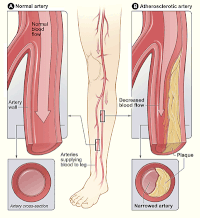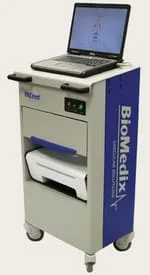What Is PAD?
Peripheral Arterial Disease (PAD) is a serious circulatory problem in which the blood vessels that carry blood to your arms, legs, brain, or kidneys become narrowed or clogged. It affects 8 million Americans, most over the age of 50. It may result in leg discomfort with walking, poor healing of leg sores/ulcers, difficult to control blood pressure, or symptoms of stroke. People with PAD are at significantly increased risk for stroke and heart attack.
Risk Factors For P.A.D.

Because only half of those with P.A.D. actually experience symptoms, it is important that people with known risk factors be screened or tested for P.A.D.
The risk factors include:
- Being over age 50
- Smoking (currently or previously)
- Diabetes
- High blood pressure
- High cholesterol
- Personal or family history of P.A.D., heart disease, heart attack, or stroke
- Sedentary lifestyle (infrequent or no exercise)
Signs and Symptoms
- Pain in the legs brought on by walking and relieved by rest.
- Pain in the legs at rest due to poor circulation.
- Poorly healing wound on lower extremity.
- Injury to lower limb or foot involving blood vessels.
- Discoloration of toes and feet.
P.A.D. and Foot Problems
Simple foot deformities (hammertoes, bunions, bony prominences) or dermatologic conditions such as ingrown or thickened fungal nails often become more serious concerns when P.A.D is present. Because the legs and feet of someone with P.A.D. do not have normal blood flow—and because blood is necessary for healing—seemingly small problems such as cuts, blisters, or sores can result in serious complications.
Having both diabetes and P.A.D. further increases the potential for foot complications. People with diabetes often have neuropathy (nerve damage that can cause numbness in the feet), so they don’t feel pain when foot problems occur. When neuropathy occurs in people with P.A.D., ulcers can develop over foot deformities and may never heal. For this reason, P.A.D. and diabetes are common causes of foot or leg amputations in the United States.
Once detected, P.A.D. may be corrected or at least improved. The foot and ankle surgeon can then correct the underlying foot deformity to prevent future problems should the circulation become seriously restricted again.
Answers to these questions will determine if you are at risk for PAD and if a vascular exam will help us better assess your vascular health status.
1. Do you have foot, calf, buttock, hip, or thigh discomfort (aching, fatigue, tingling, cramping, or pain) when you walk which is relieved by rest?
Yes No
2. Do you experience any pain at rest in your lower leg(s) or feet?
Yes No
3. Do you experience foot or toe pain that disturbs your sleep?
Yes No
4. Are your toes pale, discolored, or bluish?
Yes No
5. Do you have skin wounds or ulcers on your feet or toes that are slow to heal?
Yes No
6. Has your doctor ever told you that you have diminished or absent pedal (foot) pulses?
Yes No
7. Have you suffered a severe injury to the leg(s) or feet?
Yes No
8. Do you have an infection of the leg(s) or feet that may be gangrenous (black skin tissue)?
Yes No
What is PADnet?

A PADnet Arterial test can provide early detection of PAD when treatment options are broadest (incorporatingbothlifestyle modification, and non-invasive and invasive therapeutic options). The PADnet detects blockages in arteries and the quality of blood flow using pulse-volume recordings and segmental blood pressure measurements.
Before Your Test
Getting ready for this test requires little effort. You will be asked to remove clothing that covers your arms and legs, keeping your underwear on. You may be asked to remove your shoes and socks as well. A gown may be provided, or you may bring shorts to wear. This test most often takes 15-20 minutes. Be sure to allow extra time to check-in.
- Do not smoke or use tobacco 30 minutes prior to your PADnet+ exam. Smoking constricts the peripheral arteries and can interfere with the results.
- If you think you cannot tolerate lying flat on the exam table for the test, please let us know.
During Your Test
You will lie down on the exam table. Pressure cuffs will be wrapped snugly around your arms, above knees, calves, and ankles. The technician will inflate the cuffs, and the sensors in the machine will record the pulse waves that correspond to each beat of your heart.
Blood pressure will be recorded at your arms and ankles also. The ABI (Ankle-Brachial Index) is measured by the ratio between these pressures. PAD is diagnosed if your ankle pressure is 99% or lower than your arm pressure. With severe narrowing, the ABI may be less than 50%.
If the ABI and/or waveforms are abnormal, your doctor may recommend additional diagnostic tests.
After Your Test
You may return to your normal routine right after the test. Your doctor will let you know when the results are ready.
Avoiding P.A.D. Complications
Getting regular foot exams—as well as seeking immediate help when you notice changes in the feet—can keep small problems from worsening. P.A.D. requires ongoing attention.
To avoid complications, people with this disease should follow these precautions:
- Wash your feet daily. Use warm (not hot) water and a mild soap. Dry your feet—including between the toes—gently and well.
- Keep the skin soft. For dry skin, apply a thin coat of lotion that does not contain alcohol. Apply over the top and bottom of your feet, but not between the toes.
- Trim toenails straight across and file the edges. Keep edges rounded to avoid ingrown toenails, which can cause infections.
- Always wear shoes and socks. To avoid cuts and abrasions, never go barefoot—even indoors.
- Choose the right shoes and socks. When buying new shoes, have an expert make sure they fit well. At first, wear them just for a few hours daily to help prevent blisters and examine the feet afterward to check for areas of irritation. Wear seamless socks to avoid getting sores.
- Check your feet—every day. Check all over for sores, cuts, bruises, breaks in the skin, rashes, corns, calluses, blisters, red spots, swelling, ingrown toenails, toenail infections, or pain.
- Call your podiatrist if you develop any of the above problems or seek professional help immediately.
- Do not try to take care of cuts, sores, or infections yourself.

